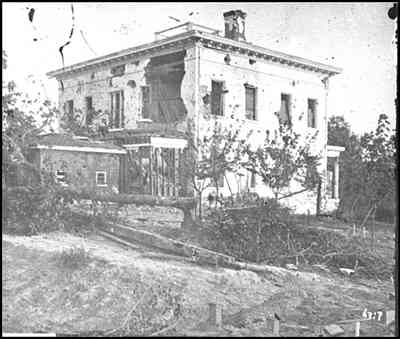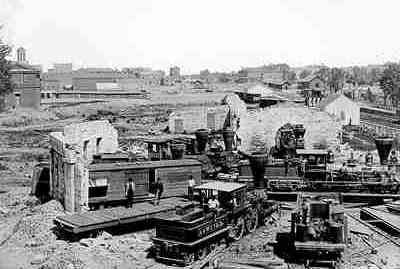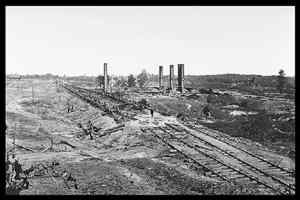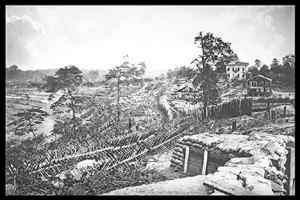Westview Area
Battle of Ezra Church, Westview Cemetery
Ezra Church: 1565 MLK Jr. Blvd. Mozley Park, Atlanta
Westview Cemetery: 1680 Ralph David Abernathy, SW, Atlanta
Not much remains of the Ezra Church battlefield,
the scene of a lopsided, bloody Union victory on July 28, 1864. Union Gen. W.T.
Sherman was determined
to cut the last railroad  supplying
Confederate
Gen. John Bell Hood's
troops located inside Atlanta's fieldworks. He sent troops under Maj. Gen. O.O.
Howard counterclockwise around Atlanta to destroy the Macon & Western Railroad
at East Point, which served the town from the south. Hood sent four divisions,
two commanded by newly arriving Stephen Dill Lee, and two others by A.P. Stewart.
Lee was to block the Federals while Stewart was to circle and come up on their
rear. On July 28, near Ezra Church, Gen. Lee, without orders and before Stewart
had arrived, launched assaults on an entrenched Union army and was severely
beaten back. When Stewart arrived, he led several unsuccessful assaults, and
became a casualty. Four assaults and three hours of fighting produced what is
considered by historians to be the most one-sided victory of the entire war,
with 3-5,000 Confederate casualties compared to 600 Federals. Gen. William Hardee
reported to Hood that this battle had broken the proud spirit of the Army of
Tennessee. Ten days and three battles since taking command, Hood had lost one-third
of his infantry attacking entrenchments. Historical markers
are found in and around Mozley Park, the main part
of the battlefield where the log chapel Ezra Church was located. Nearby Westview
Cemetery is another protected part of the
battlefield, where Confederates rushed up to charge the center of the Union
line. The solitary grave of Lt. Edward Clingman,
killed at Ezra Church, is marked with engravings of a saber, pistol and
Confederate flag, and is located along the eastern outer drive. Behind the grave
is a section of Confederate trenches.
On a nearby hilltop, a large marble soldier,
one of the few monuments ever erected by Confederate veterans, stands guard
over fallen comrades. The inscription speaks of peace: "Nation shall not
rise up against nation. They shall beat their swords into plough shares and
their spears into pruning hooks. Neither shall they learn war anymore. Of Liberty
born of a Patriots dream; of a storm cradled Nation that fell."
supplying
Confederate
Gen. John Bell Hood's
troops located inside Atlanta's fieldworks. He sent troops under Maj. Gen. O.O.
Howard counterclockwise around Atlanta to destroy the Macon & Western Railroad
at East Point, which served the town from the south. Hood sent four divisions,
two commanded by newly arriving Stephen Dill Lee, and two others by A.P. Stewart.
Lee was to block the Federals while Stewart was to circle and come up on their
rear. On July 28, near Ezra Church, Gen. Lee, without orders and before Stewart
had arrived, launched assaults on an entrenched Union army and was severely
beaten back. When Stewart arrived, he led several unsuccessful assaults, and
became a casualty. Four assaults and three hours of fighting produced what is
considered by historians to be the most one-sided victory of the entire war,
with 3-5,000 Confederate casualties compared to 600 Federals. Gen. William Hardee
reported to Hood that this battle had broken the proud spirit of the Army of
Tennessee. Ten days and three battles since taking command, Hood had lost one-third
of his infantry attacking entrenchments. Historical markers
are found in and around Mozley Park, the main part
of the battlefield where the log chapel Ezra Church was located. Nearby Westview
Cemetery is another protected part of the
battlefield, where Confederates rushed up to charge the center of the Union
line. The solitary grave of Lt. Edward Clingman,
killed at Ezra Church, is marked with engravings of a saber, pistol and
Confederate flag, and is located along the eastern outer drive. Behind the grave
is a section of Confederate trenches.
On a nearby hilltop, a large marble soldier,
one of the few monuments ever erected by Confederate veterans, stands guard
over fallen comrades. The inscription speaks of peace: "Nation shall not
rise up against nation. They shall beat their swords into plough shares and
their spears into pruning hooks. Neither shall they learn war anymore. Of Liberty
born of a Patriots dream; of a storm cradled Nation that fell."
- I-20 West to Martin Luther King Jr. exit. Turn left and drive under
the bridge, and turn left again onto Ralph David Abernathy. Cemetery entrance
will be on the right.
Utoy Church 
Cahaba Dr., SW, Atlanta
The Battles of Utoy Creek, Aug 5-7, 1864, were Confederate victories. During
the Siege of Atlanta, Sherman
again tried to work his men closer to the Macon & Western Railroad by flanking
the Confederate defensive line. While two of Sherman's
generals squabbled, Gen. William Hardee extended his lines and entrenched on
a ridge to meet the threat near Utoy Creek. The Yankees attacked the Orphan
Brigade, but were bloodily repulsed. The next day they tried again, with even
worse results. The Union quit the field with several hundred Federal casualties.
The Confederates lost several dozen. The battlefield today is in Cascade Springs
Nature Preserve (Instead of turning onto Centra Villa, continue driving on Cascade,
which was the front line of the battle. Historical
markers will be on the right, the nature preserve on the left). Utoy
Church, circa 1828, is located two miles east of the battlefield at Venetian
and Cahaba drives. The oldest Baptist church in present Fulton County, today
Utoy Church is the Temple of Christ Pentecostal Church, Inc. This church served
as a Confederate hospital, and apx. 25 Confederate graves from the Battle of
Utoy Creek and the
Battle of Atlanta are located in the northwestern cemetery,
as is a portion of the Rebel defensive line a few feet north. In Adams Park,
also located off Cascade, is a historical
marker at the top of the 17th tee, marking the  location
of some of the few remaining Confederate entrenchments
from the Siege of Atlanta.
location
of some of the few remaining Confederate entrenchments
from the Siege of Atlanta.
- Turn right out of Westview Cemetery onto Ralph David Abernathy. Travel
.8 mile and turn right onto Cascade (GA 154). Travel 1.6 miles and turn left
onto Centra Villa. Travel .5 mile and turn left onto Venetian. Drive .3 mile
and turn left onto Cahaba. On the corner is Utoy Church.
Surrender Marker, Fort Hood, Change of Command Marker
Northside Dr. & Marietta St., Atlanta
Not much remains at this location from the Civil War, but the historic event
that took place here changed the nation. Lincoln's presidency and the Union
was saved — and the Confederacy was doomed — after the fall of Atlanta.
This is probably the most important Civil War event in Georgia. A historical
marker, titled "Surrender of Atlanta,"
tells the story: Gen. Hood, in person with Stewart's A.C. and the Georgia
Militia abandoned the city, Sept 1, as a result of Hardee's defeat at Jonesboro,
August 31, and marched S. to Lovejoy's Station. Federal forces at Chattahoochee
River Crossings, since Aug. 25, suspecting the evacuation of the city on hearing
loud explosions, sent forward a reconnaissance to investigate. At this point
it met Mayor James M. Calhoun with a committee, who tendered the surrender of
the city, asking protection for citizens and property. Col. John Coburn, vice
Maj. Gen. Henry W. Slocum, com'd'g 20th A.C. received the surrender. A short
distance southeast from here at 793 Marietta St., a plaque
on the Wells Fargo building and a street named Fort Hood Place mark the
site of Fort Hood, which stood on the city's northwest
fortifications. A stack of cannon balls, on
950 West Marietta Rd., marks the location of the marks the Dexter Niles
House site, where Confederate Gen. Joseph Johnston learned he was replaced
by Gen. John Bell Hood.
Read
and add comments about this page
Reader-Contributed Links to the Civil War in Georgia Book:
 supplying
Confederate
Gen. John Bell Hood's
troops located inside Atlanta's fieldworks. He sent troops under Maj. Gen. O.O.
Howard counterclockwise around Atlanta to destroy the Macon & Western Railroad
at East Point, which served the town from the south. Hood sent four divisions,
two commanded by newly arriving Stephen Dill Lee, and two others by A.P. Stewart.
Lee was to block the Federals while Stewart was to circle and come up on their
rear. On July 28, near Ezra Church, Gen. Lee, without orders and before Stewart
had arrived, launched assaults on an entrenched Union army and was severely
beaten back. When Stewart arrived, he led several unsuccessful assaults, and
became a casualty. Four assaults and three hours of fighting produced what is
considered by historians to be the most one-sided victory of the entire war,
with 3-5,000 Confederate casualties compared to 600 Federals. Gen. William Hardee
reported to Hood that this battle had broken the proud spirit of the Army of
Tennessee. Ten days and three battles since taking command, Hood had lost one-third
of his infantry attacking entrenchments. Historical markers
are found in and around Mozley Park, the main part
of the battlefield where the log chapel Ezra Church was located. Nearby Westview
Cemetery is another protected part of the
battlefield, where Confederates rushed up to charge the center of the Union
line. The solitary grave of Lt. Edward Clingman,
killed at Ezra Church, is marked with engravings of a saber, pistol and
Confederate flag, and is located along the eastern outer drive. Behind the grave
is a section of Confederate trenches.
On a nearby hilltop, a large marble soldier,
one of the few monuments ever erected by Confederate veterans, stands guard
over fallen comrades. The inscription speaks of peace: "Nation shall not
rise up against nation. They shall beat their swords into plough shares and
their spears into pruning hooks. Neither shall they learn war anymore. Of Liberty
born of a Patriots dream; of a storm cradled Nation that fell."
supplying
Confederate
Gen. John Bell Hood's
troops located inside Atlanta's fieldworks. He sent troops under Maj. Gen. O.O.
Howard counterclockwise around Atlanta to destroy the Macon & Western Railroad
at East Point, which served the town from the south. Hood sent four divisions,
two commanded by newly arriving Stephen Dill Lee, and two others by A.P. Stewart.
Lee was to block the Federals while Stewart was to circle and come up on their
rear. On July 28, near Ezra Church, Gen. Lee, without orders and before Stewart
had arrived, launched assaults on an entrenched Union army and was severely
beaten back. When Stewart arrived, he led several unsuccessful assaults, and
became a casualty. Four assaults and three hours of fighting produced what is
considered by historians to be the most one-sided victory of the entire war,
with 3-5,000 Confederate casualties compared to 600 Federals. Gen. William Hardee
reported to Hood that this battle had broken the proud spirit of the Army of
Tennessee. Ten days and three battles since taking command, Hood had lost one-third
of his infantry attacking entrenchments. Historical markers
are found in and around Mozley Park, the main part
of the battlefield where the log chapel Ezra Church was located. Nearby Westview
Cemetery is another protected part of the
battlefield, where Confederates rushed up to charge the center of the Union
line. The solitary grave of Lt. Edward Clingman,
killed at Ezra Church, is marked with engravings of a saber, pistol and
Confederate flag, and is located along the eastern outer drive. Behind the grave
is a section of Confederate trenches.
On a nearby hilltop, a large marble soldier,
one of the few monuments ever erected by Confederate veterans, stands guard
over fallen comrades. The inscription speaks of peace: "Nation shall not
rise up against nation. They shall beat their swords into plough shares and
their spears into pruning hooks. Neither shall they learn war anymore. Of Liberty
born of a Patriots dream; of a storm cradled Nation that fell."

 location
of some of the few remaining Confederate entrenchments
location
of some of the few remaining Confederate entrenchments